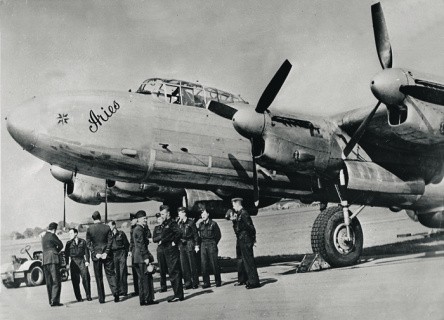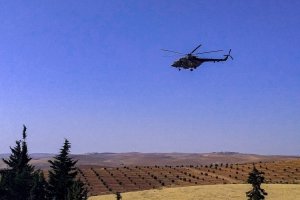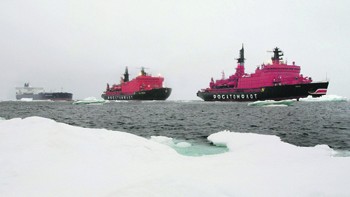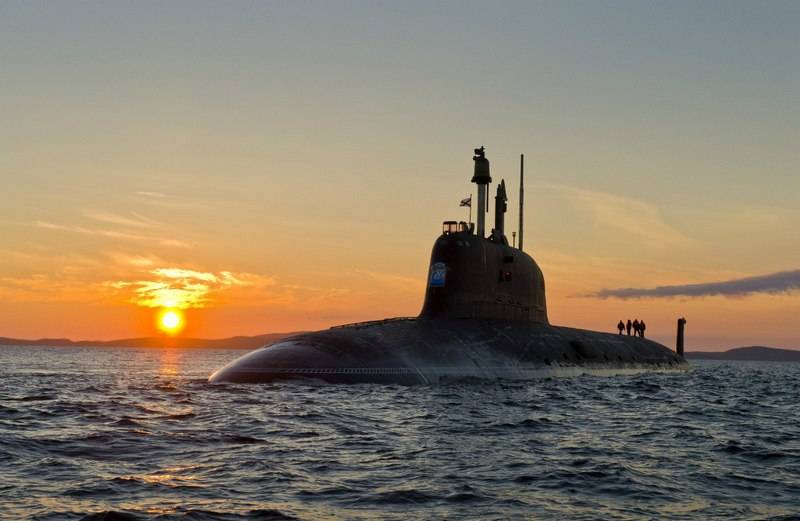
British reconnaissance plane "Avro Lancaster", 16 May 1945 years starting from the airport in Iceland, He flew to the North Pole and returned. Photos from the site www.awm.gov.au
25 October 2019 in St. Petersburg, was launched on a military icebreaker "Ivan Papanin". It is the lead ship of the project 23550. Its displacement around 8500 tonnes, speed 18 knots. Icebreaker is equipped with modern artillery and missile weapons. On board, he will have a helicopter, unmanned aerial vehicles, hovercraft project 23321 "Pallas" etc. Some media raised the question of the expediency of construction of military icebreakers, and even of this size.
Alas, immediately after the Second World War, the Arctic has become a field of battle of the Cold War. Already a week after the victory over Germany, the most powerful British bombers "Lancaster", 16 May 1945 years starting from the airport in Iceland, He flew to the North Pole and returned.
Since the fall 1946 , American Flying Fortress B-29 started regular flights from the airbase Fairbank (Alaska) - North Pole and back. AT 1947 , US bombers first began to sit on the ice airfield T-3.
24-November 25 1956 , eight strategic bombers B-52 carried out combat patrols in the Arctic, flying without landing, but with the in-flight refueling 27 thousand. km. Since then, and up to 2019 year such flights in the Arctic occur regularly.
Soviet pilots also began to use airfields in the Arctic ice. 7 May 1948 three years of La 11, accompanied by the leader of the Tu-6 took off on an ice floe and made a safe landing 8 May. After completing a few missions from the ice, they went back.
It was later performed several such expeditions, followed by La-11 began to regularly keep watch on the Protection of the USSR northern borders. At the end of the 1940s on a drifting ice floe based regiment of fighters La-11.
In March-April 1950 , two passenger aircraft IL-12E Polar aircraft was towed to the Chkalovsky airfield outside Moscow to the North Pole two cargo glider C-25, delivering the first assault of this kind. Then the planes sat on the ice airfield, They took gliders and towed them to Krasnoyarsk.
In parallel to the USSR 1948 year in CDB-18 was started designing "special purpose boats" project 621. The boat was designed for the covert transfer of airborne troops with combat equipment and ammunition and then landed troops ammunition supply, fuel and food. In determining the composition of the landings came from the, that all members of his military units (shooting, artillery, tank, aeronautical etc..) They appear as independent units, and their placement is made with the possibility of fighting in the landing time. For taking a boat fighter aircraft had to be ensured catapult take-off type device. Weight of transported landing with appliances, including food, drinking water and air regeneration cartridges, was 1550 t.
Boat project 621 It must have had a normal displacement 5845 t, length 147,5 m, width 13,3 m and the mean draft 6,3 m. Maximum surface speed - about 15 knots, maximum underwater speed - 8,4 host. Cruising range surfaced - 6000 miles.
But where had landed troops from gliders and submarines? Near the US air bases in Greenland and Iceland. present a picture: Greenland, polar night. But life on the American air base does not stop: revolve radar, take off and land heavy aircraft.
Suddenly airfield attendants saw hundreds fleeing ghosts in white robes. mirage? No, not a mirage, betonku on the runway with a roar jumped tanks T34, the move to open machine-gun fire. Within minutes it was all over. Pilots and ground crew were standing with their hands raised. Protection and service staff communication systems and radar even less fortunate: I deal with them subversive group for three minutes before the tanks to the runway. It took a little more time, and base alive - on concrete-surfaced road, one after another landed flying fortress, Only now they were not white, and red stars. Aircraft refueled and headed for the south…

Capitalist Russia Industry. Long jump or running in place?
And indeed, There were plans capture airfields in Greenland and Iceland followed using their Soviet strategic bomber.
In the meantime, Soviet bombers landed on ice airfields. So, at 1950 , the Soviet long-range bomber Tu-4 landed on an ice floe near the drifting station NP-2 (the military called "base north-5") FROM 1958 year ice near the station SP-6 got three jet bomber Tu-16. Sat on the ice even super-heavy bomber Tu-95.
Design of the first military icebreaker began in 1937 year in CDB-32 (now "Baltsudoproekt") commissioned by the NKVD Morpogranohrany. 17 December 1938 , the plant "Sudomech" (now the North platform "Admiralty Shipyards") was laid patrol ship icebreaker "Purga" project 52. 24 April 1941 year "Purga" was launched on. Its entry into operation was planned in the same year. But with the beginning of the war, construction of icebreaking vessel, who had the willingness 28%, stopped, and the unfinished ship was mothballed. Construction resumed only in 1951 year and lasted for about five years. Icebreaking ship "Purga" was put into operation 31 Martha 1957 of the year.
Full displacement "Purga" is 4000 t. Full speed 17 knots. Cruising range 8500 10 miles sites progress and 3467 17 miles sites. autonomy 35 day. artillery armament: Four 100 mm Fitting B-34USMA and six double-barrel 37 mm in machine-11M. A four mortars anti BMB-2 (70 GB) and 30 min KB.
In the years 1973-1981 in order to enter one year military icebreaker project 97P displacement 3800 t. "Ivan Susanin" and "Ruslan" built as icebreakers for the navy patrol (weapons with them subsequently removed), other ships - as a PSKR marine parts Border Troops KGB. Both versions of the project 97P did not differ from each other.
Armament ships 97P project were twin 76-mm gun mounts AK-726 to STS "Turret", as well as two six-barreled AK-630M automatic control system with "Vympel" and one helicopter Ka-25PS, later Ka-25PG.
Few people know, that the project all the Soviet nuclear-powered icebreakers were at war time or period of threat to carry artillery armament. So, nuclear-powered icebreaker "Lenin" was equipped with a foundation, cellars and other equipment for quad 45mm machine SM-20-ZIF1.
At the beginning 1975 year broke a huge scandal in agitprop. On the cover of the magazine "Ogonyok" was placed a large photograph of the icebreaker "Arktika". All would be good, but fans have seen all there in the photo gun mount AK-726. And indeed, mobilization type arming icebreakers "Arctic" provides for two twin 76-mm installation AK-726 and AK-four shestistvolki 630. With these weapons, "Arctic" and passed the state tests.
10 August 1964 the Central Committee of the CPSU and the USSR Council of Ministers issued a joint decree № 680-280 on the establishment of the masked surface missile in the USSR. Order of the Commander of the Navy from 27 February 1965 , the project was named "Scorpio".
On the basis of an intercontinental ballistic missile UR-100 VN. Chelomei designed ship missile complex D-8 missiles UR-100M. However, the Navy management recognized more suitable complex D-9 to R-29.
The complex D-9 includes eight ballistic missile R-29. They were kept with a five-minute readiness for the start of full gear and tucked propellants in unified submarine project 667B vertical shafts at 4C-75 launchers. It envisaged the possibility of finding the rockets on the ship for six months.
The transport ships ice navigation project was chosen as a carrier 550 (type "Aguema"), standard which were built at the time in Komsomolsk-on-Amur and Kherson.
These deadweight 8700 t have icebreaking hull form, propeller with detachable blades and diesel-electric power plant, allowing them to work independently on the Northern Sea Route (AMS).
However, for several reasons, mainly of a political nature, Arctic missile project was not implemented.
In the years 1950-1970 the US and the Soviet generals have developed ambitious accommodation projects in the Arctic fantastic weapons.

Pro-Turkish forces destroyed the headquarters of Kurdish terrorists in the Syrian province of Hasaka
here, for example, "Operation Ice Worm". AT 1950 the Americans started the construction of the Thule Air Base. This is the northernmost US air base, she is in 1118 km north of the Arctic Circle and in 1524 km from the North Pole.
Construction of Tula at a cost of 1,9 billion dollars. prices 1953 of the year. This amount included the cost of the airfield, warehouses, Radar stations and the campus on 15 thousand. residents.
Individual articles went placement financing of air defense systems: interceptors F-102 and anti-aircraft missiles. Initially, these were missiles "Nike-Ajax", and in the early 1960s, they were replaced by "Nike Hercules". The latter were fitted with warheads with nuclear warheads W-31 capacity 20 CT, that is equal in power bomb, Hiroshima.
FROM 1954 in Alaska at the airbase Ailsa, and with 1955 Thule Air Base, on the steel-based motor 10 strategic bombers-36D. Formally, Tula and Ailsa were "airfields", but in fact the strategic bombers had been there for weeks, or even months.
In early February, 1956 , President Eisenhower approved the operation "homerun" ("The way home"). To carry it out at Thule AFB formed special aircraft compound composed strategic bomber embodiment the intelligence: 5 RB‑47H и 16 But-47Е, and 28 Aircraft Refueling COP-97.
During the "home run" for seven weeks, Americans spent 156 reconnaissance missions near and over the Soviet Union. So, 6 May 1956 RB, six-47e passed over Ambarchik to Anadyr and back. 15 May 1956 He was followed by the official Moscow protest. But as usual, Washington in response note referred to "pilot error in difficult weather conditions of the Arctic".
AT 1957 , the Danish government has announced a huge Greenland Denuclearization. A few months later at the base of Thule began to sit vosmimotornye strategic bombers B-52, each carrying four hydrogen bombs. So that the Danish Government with the tale of "nuclear-free zone" outdid old Andersen.
21 January 1968 year seven miles south of the base of Thule crashed bomber B-52 thermonuclear bombs on board, which led to the radioactive contamination of large areas. Of the four hydrogen bombs Mk-28F1 power in 1,45 mt three were found, and one still lies somewhere at the bottom of Smith Sound.
In the late 1950s, the Pentagon has decided to deploy ballistic missiles in Greenland. AT 1960 year Army Engineering Research Center (AINTS) It was developed by the project "Ice Worm" (English. Project Iceworm) the placement network of mobile nuclear missile launch sites under the ice sheet of Greenland.
AINTS proposed to dig a network of tunnels under the ice: trench cover the arched domes, more about the shelter will take care the nature of Greenland, covering them with snow and ice. The tunnels had to connect launch pads medium-range missiles, which were supposed to be placed at distances 6,5 km another another. The total length of the planned tunnels had to be about 4000 km, the total number of rockets, planned for the development of the "Iceman", which are supposed to be placed at the base - 600.
Rocket "Iceman" was developed based on intercontinental ballistic missiles "Minuteman": Range reduced from flight 10 000 to 6100 km, warhead capacity 2,4 mt. Launch sites were to be interconnected railways.
The most interesting thing - provide electricity to plan rocket base Kepm-Century using small nuclear reactors.
spring 1959 construction began ice-missile base, and the following year there were taken the first nuclear reactor, commissioned in March 1961 of the year.
Alas, "It was smooth on paper, but forgot about the ravines ". In the mid-1960s it became clear, that the movement of glaciers in the ice sheet is much more intense, than expected when planning, and the destruction of erected objects in the ice occurred about two years after the completion of the. As a result, the facility operation was discontinued in 1967 year. Remnants of its facilities and waste, including radioactive, left in place, as expected, that they will be forever buried under a layer of snow.

The repatriation of the released Kurdish militants IG * in Russia is possible only after checking them in Syria
Here is an example of Soviet science fiction. Winter in the Arctic Circle, bezlyudnыy horystыy coast, sea, icebound. And suddenly in the band of a few hundred meters begins to melt ice. Miracle occurs by the emission of hot air from special pipes, laid along the water-runway. The air heats the water, and most importantly warm water circulates from the bottom to the surface. With the steep cliffs on the crumbling snow, rising steel plate, and from rock shelters a boat slowly brings reactive flying boat with two suspended under the wings missiles.
The boat takes off with an artificial hole in the ice and takes a course to the south. Somewhere in the tropical sea, for example in the archipelago of the Antilles and the eastern Pacific Ocean, flying boat conducts refueling submarine-tanker. Then the boat takes off and heads for US.
On the southern United States before the appearance of Fidel Castro never expected an attack. Namely, in the south, our boat is close to the states.
In any case, she would not have come in the near zone defense major cities or military facilities. From a distance 110 km boat could start flying bombs K-12BS and 2500 km - aircraft missiles X-44. Firing both missiles, the boat goes in the opposite direction and be a rendezvous with the submarine tanker. But this time it will not only fueling. With the submarine with a special inflatable raft on a plane a couple of overloaded aircraft missiles for the new plaque. In the meantime, "the combat vehicle crew" splashing in the tropical sea, his place is taken by relief crew.
The unprecedented atmosphere secrecy in Moscow in DB-23 in November 1955 the year was begun designing a supersonic flying boat (seaplane) M-70. Takeoff weight it had to be 240 t. But he could take off even when the solid state up to 4 points inclusive, that is, when a wave of up to 1,8 m. The maximum speed of a flying boat M-70 was supposed to reach 2500 kmh, ie almost yes times the speed of sound.
The flight range of M-70 without refueling 7000-7500 km, and two fill-ups - 23 000–24 000 km, that is, the boat could reach and return from any point on the globe.
The main arms hydroplane M-70 were ballistic cruise missiles X-44 design Myasishcheva DB-23 or P-6 DB-52 structure Chelomeya. There were loads of other options, in particular guided bombs type BWM 3 or sea mines in four dimensions FAB-1500.
In parallel with the supersonic seaplane M-70 Myasischev engaged in the development of a seaplane with a nuclear power plant 60M. The work was done in accordance with the order from Minaviaproma 16 April 1956 , the number of M-40/1982 and the decision of the Council of Ministers on 15 August 1956 year number 1119-582.
AT 1957 year project was completed coastal seaplane bases on the Kola Peninsula BOM. Inside the rock was created by several seaplane base, includes, besides hangars service station stores. The conclusion of such a seaplane base was carried out by means of special pontoons.
Creation of underground bases seaplanes on the Kola Peninsula was quite capable of Soviet engineers. Recall, that at about this time it was built underground submarine base in Balaklava. However, progress in the development of intercontinental ballistic missiles have caused the cancellation of work on jet-missile seaplanes in the USSR, and the US.
However, the establishment in the XXI century sufficiently effective missile defense systems in the United States has forced Russia to return to the "fantastic" weapons with nuclear engines - a cruise missile "Petrel" and submarine drones "Poseidon".
Not hard to guess, that "Petrel", and "Poseidon" tested, and subsequently will be based in the Arctic.
clear, that "Petrel" and "Poseidon" - a "doomsday weapon". But the icebreaker "Ivan Papanin" will defend Russia's interests in peacetime. The blessing is now the United States and NATO countries need to "internationalize" the Northern Sea Route.
Who owns the Northern Sea Route? To our fathers, grandfathers, it was the easiest question in geography class. Pomors in XIV century went to the New Earth and Grumandu (Svalbard). In the years 1640-1668 Ataman Dezhnev passed on kochah from the mouth of the Lena River to the mouth of the Anadyr, simultaneously opening the Strait, later named after him. But in the course of the Great Northern Expedition in 1734-1741 years Russian naval officers surveyed along the coast of the Northern Sea Route.

Shoigu told, that the forum "Army" for the first time will combine with the army games
AT 1878 year for the first time in history the wooden schooner "Vega" of the Swedish navigator Nordenskjöld passed the Northern Sea Route. But few people know, what in 1878 year, specially by order of the merchant Alexander Sibiryakov, the iron screw steamer "Lena" of the "river-sea" class was built in Sweden. Sibiryakov hired the Swede Johansen to command it. Well, Nordenskjold asked to be a companion. It was so or a little differently, but it was the iron "Lena" that was the first to cross Cape Chelyuskin, and behind her was the wooden schooner "Vega" with Nordenskjold.
|
|
| AT 2018 year along the Northern Sea Route not a single American ship passed. Photo from the site www.rosatomflot.ru |
28 August 1878 years "Lena" and "Vega" came to Tiksi at the mouth of the Lena River. Then "Lena" went up the river, and "Vega" - to the east. "Lena" walked along Lena for many years, later repeatedly went to sea, went to the mouth of the Yana, etc..
At the beginning of the twentieth century, the movement of Russian ships in the Arctic became a routine phenomenon. 25 September 1905 year newspaper "Siberian leaf" № 75 I wrote: “We left the Yugorsky ball for Yeniseisk on the first of August, under the command of Lieutenant Colonel Sergeev and Lieutenant Melyamov, steamers: "Yeniseisk", "Turukhansk", "Angara", "Lena" and "Krasnoyarsk" indicator strength 450-850 forces, speed 11-14 knots, draft 5-6 ft.; coal furnace, Besides, 10 barge, also iron, loaded with coal, draft six to nine 3 foot., with a capacity of 500-800 tons, to the mouth of. Yenisei ".
Pay attention, there was no need for transit flights on the NSR until the early 1930s, although dozens of steamers sailed along its route every year.
17 December 1932 year, by the decree of the Council of People's Commissars of the USSR, a single transport and economic body was formed - the Main Directorate of the Northern Sea Route (Glavsevmorput), which was responsible for the technical equipment of the track, organization of regular transportation and ensuring the safety of navigation along this route.
Well, who owned the Arctic? AT 1921 year Canada declared, that all lands and islands north of her continental possessions fall under her sovereignty.
AT 1926 year, the Central Executive Committee and the Council of People's Commissars of the USSR adopted a similar decision. This is how the sectoral division of the Arctic arose. She shared only five countries - the USSR, Norway, Denmark, USA and Canada - into sectors, the peaks of which was the North Pole, bases - the northern borders of these states facing the pole, and the sides were the values of geographical longitude.
To 1991 of the year, the sectoral division of the Arctic has not been seriously disputed. But in 1997 Yeltsin's Russia signs the Convention on the Law of the Sea 1982 of the year. It grants coastal states control of the continental sea shelf (seabed and subsoil of underwater areas, outside the territorial waters of the state). Wherein, according to the 76th article of the convention, no country has the right to establish control over the Arctic, but states that have access to the Arctic Ocean may declare territory as their exclusive economic zone, extending to 200 miles from the coast. This zone can be extended by another 150 nautical miles, if the country proves, that the Arctic shelf is an extension of its land territory. In its economic zone, the coastal state has the preferential right to extract minerals.
Convention 1982 year at the very least is approaching the Atlantic, but completely unacceptable for the Arctic. In the Russian sector of the Arctic, according to convention 1982 of the year, Russia owns all the islands without exception, and the neutral territory is the central part of the Arctic Ocean, permanently covered with ice in winter and partly in summer.
Get there, except for the edges of the Russian sector, can, only using the Northern Sea Route and entering the territorial waters of Russia. Polar stations can be delivered to the Russian sector by planes or submarines across the Pole, research or spy equipment. But any economic use of the disputed waters in the polar regions of the Russian Arctic is technically impossible..
curious, did they know, who signed the convention 1982 of the year, that the sectoral boundaries of the USSR in the Arctic were stable, and now they have become floating. Scientists will discover a new ridge - and the Russian Federation or Canada declare a huge chunk of the Arctic as their economic zone.

The transfer of videoconferencing Forces in northern Syria to help secure military police patrol from the Kurds
In the Russian sector of the Arctic, our scientists with 1997 years have discovered several dozen islands, which became the territory of the Russian Federation, and "closed" several islands, turned out to be centuries-old ice fields. curious, what in 2019 year Chuvash schoolchildren, sitting at home on the couch and studying space images, discovered a small island in the Kara Sea and named it after cosmonaut Andrian Nikolaev.
think, who needs uninhabited mountainous islands? But the annexation of the island-rock gives the power 1172 quarter. km (!) territorial waters. And an island the size of 10 miles brings already 2250 quarter. km, etc.. At the bottom of these waters can be hydrocarbons and other minerals. And Russia has the right not to let anyone into its territorial waters.
I note, that in 1932-1991, except for Soviet, no other merchant ships passed through the Northern Sea Route. And not because, that Moscow did not let them in, and due to lack of commercial benefit. only in 1991 year foreign ships were allowed to pass along the NSR. However, the first two foreign ships passed there only in 2009 year. AT 2011 year they turned out 34, in 2012 - 46. Well, then the number of ships, transiting along the Northern Sea Route, dropped to 18 (!) at 2015 year.
for comparison: through the Suez Canal to 2011 the year followed 18 thousand. courts! well and 6 August 2015 the second Suez Canal was opened, parallel to the old. As a result, the capacity of the Suez Canal has increased, and the transit time has decreased.
AT 2018 year, cargo transportation along the Northern Sea Route has increased compared to 2017 since 10,7 million to 19,7 million tons, ie 84%. According to the SMP c 2018 it took about 800 courts, of which only transit flights were 27, and of these, ships flying a foreign flag only 17. Of these, not a single American.
Still the United States, Norway and several other countries officially consider, that the Northern Sea Route is an international sea route. Communications of the Arctic, they say, are "the common heritage of all mankind".
The scope of the article does not allow dwelling on the Canadian-Russian dispute over the shelf off the Lomonosov Ridge. But it's clear anyway, that oil and gas production in the Russian sector of the Arctic beyond the 200-mile (370‑ Kilometer) the Russian economic zone is physically impossible without technical assistance from the Russian Federation and the use of the Northern Sea Route. And the NSR in many places passes through the territorial 12-mile waters of Russia, and Moscow has the right to decide, who to let there, and who is not.
In the Arctic, the situation is similar to the Maidan. None of the owners of the few foreign ships, passing along the NSR, does not complain. Everyone is happy with Russian rules. Meanwhile, the White House demands an internationalization of the path and prepares for Arctic adventures..
clear, that there are no economic dividends for the United States, in the EC, nor the Asian countries will receive in the event of the internationalization of the Northern Sea Route. The US goal is to create a military threat to Russia from the North, this is the minimum program. And the maximum program is the capture of Siberia, what will be followed by the collapse of the whole of Russia.
The Pentagon plans to bring dozens of cruisers and destroyers to the Northern Sea Route - carriers of the Tomahawk cruise missiles and the Aegis missile defense system. On board everyone is 90 universal vertical launchers. The type of rockets varies from mission to mission, delivered to the ship.
Aegis missile defense system can shoot down Russian ICBMs on ascending trajectories, launched in silos of launchers and nuclear submarines. Note, that all our ICBMs are programmed to fly across the North Pole.
Tomahawk cruise missiles have a range 2200 km and from the NSR can affect almost the entire territory of Russia, including Moscow, Volgograd, Chelyabinsk, Novosibirsk, Yakutsk, Komsomolsk-on-Amur, Petropavlovsk-Kamchatsky, etc..
Well, the maximum program is the rejection of Siberia from Russia. Our media write about the Northern Sea Route mainly as a transit route from Murmansk to Vladivostok. But the overwhelming majority of ships on the route do not make end-to-end voyages., and they carry goods to Siberia and back.
In Siberia 12 navigable rivers flow from south to north and empty into the Arctic Ocean. And if in the 1920s, the supply of Yakutia was only for 10% came from the Arctic Ocean, then in the mid-1940s it increased to 50%. The supply went along the Lena and further along the NSR. The same can be said about Kolyma., Jane, Indigirke, Yenisei, Ob and other rivers. Russian North, where lives 1% population of the Russian Federation, gives 20% Russian exports!

competition field - space. Money for the US space war with Russia and China
Taking control of the Northern Sea Route, US Navy will be able to operate the Northern Delivery. Formally, you can find fault with anything, to the same ecology. Well, the merchant ships of the West will move uncontrollably along the coast of Siberia, go up the rivers, smuggle, carry out "humanitarian aid", establish contacts with separatists.
Not hard to guess, what a lot of money you can find a bunch of people, demanding "independence". Recall, how in 2014 year a handful of bandyugans terrorized Odessa. And the Center will try to put things in order, US marines in "UN blue helmets" will sail along the NSR and the rivers of Siberia.
The internationalization of the Northern Sea Route for Russia will become the implementation of the proverb "the claw is stuck - the whole bird is an abyss".












